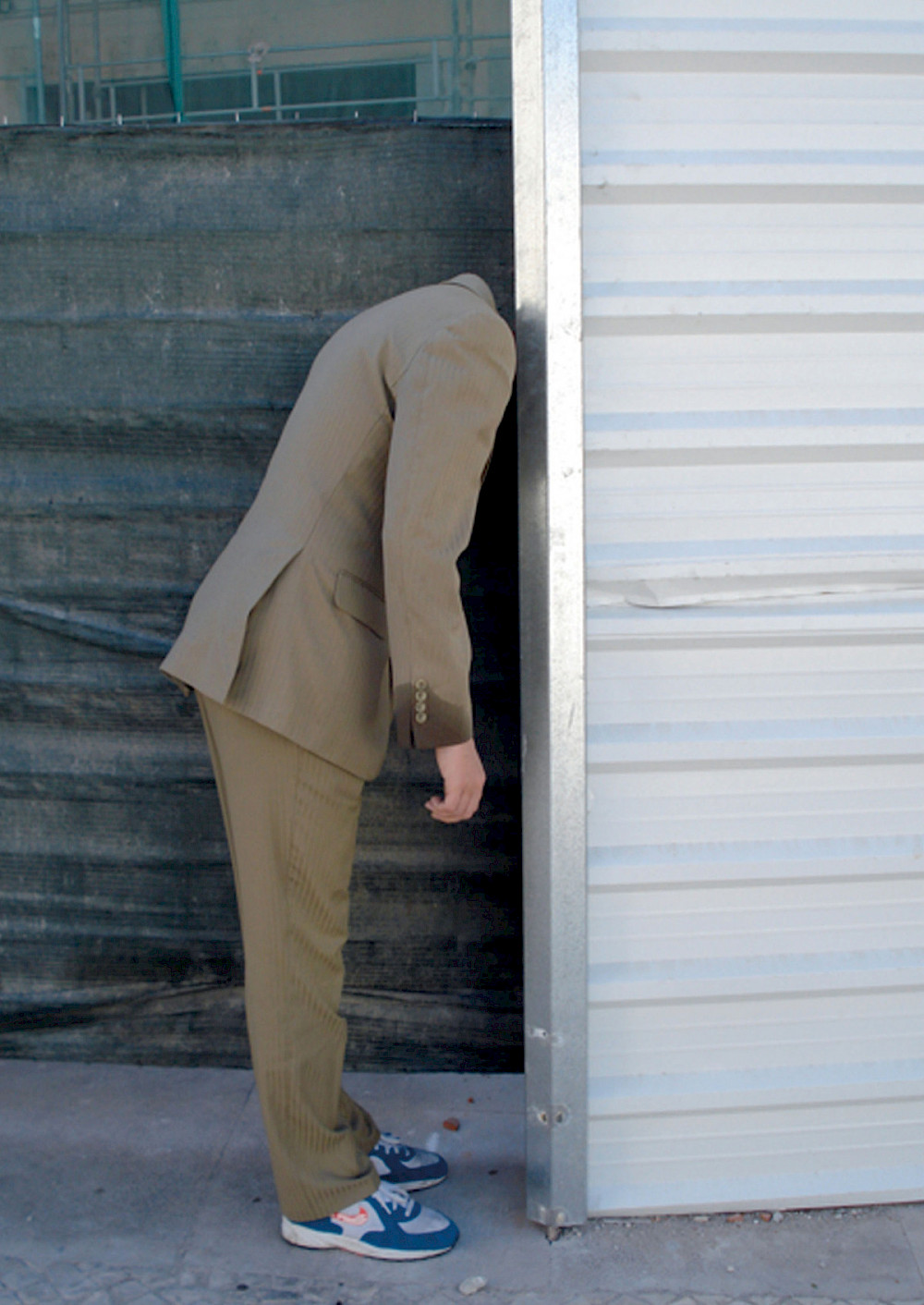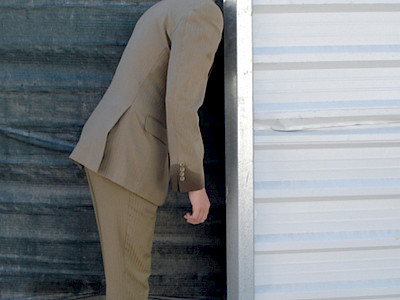10 — 13.05.2012
A theatre maker who has come from the world of visual arts, Miet Warlop’s work involves a blend of disciplines. Creating animated sculptures, tableaux vivants and performative actions in her workshop like autonomous plastic materials, she assembles them into unusual forms that investigate the device and dramaturgy of theatre. In ACT/COLLECTION, Trailer Park , performed at the Kunstenfestivaldesarts 2011, she let her strange creatures cohabit in a space in which the audience could move freely. However with her new creation, Warlop focuses our attention on a panoramic space, a theatre stage on which she unleashes a fantastical procession. Headless women, giants’ trousers, a crepuscular traffic jam, a journey on the moon and a black storm that carries away everything in its path: Mystery Magnet sketches out a haunted world where humour is born from sadness, magic from the prosaic and excitement from fear. Imagination in power!
Miet Warlop’s Mystery Magnet
Miet Warlop trained as a visual artist, but her way of dealing with images – her intuitive way of responding to images and her way of pursuing them – propelled her into theatre. This medium swap has resulted in a body of work that challenges and reanimates the conventions of theatrical representation from the perspective of its physical and material foundations. Warlop recognises the affective potential of images all around her, extracts them out of the blur of our media-saturated life, and pulls them into focus by giving them concrete shape. She does not deduce her visual ideas from verbal concepts nor does she unite them in a pre-conceived narrative. Instead, she follows the conditions and demands that an image poses once it becomes materialised, once it becomes a picture. It can be helpful to make a distinction here between ‘images’ – those spectral entities that travel across space and time, between minds and media, and constitute a shimmering reality of their own – and ‘pictures’, the materialisations of images that we can physically perceive, and relate to, in this or that medium.
Giving the image a preliminary, sculptural form in her studio, engaging with it in probing gestures, Warlop lets herself get caught up in the sculptural process. Like a hunter chasing beautiful specimens of some rare species, by following the trail of her visual fixation she frequently finds herself in uncharted territory. Her working process proceeds by tugging at the picture, nudging it into this or that direction, provoking it to yield a response, reveal an attitude. It as if she dares the image to speak through the material dress it has taken on, to give a sign of where it wants to go. And materials, as any craftsman will tell you, are stubborn and recalcitrant, yet open to negotiation – on their own terms. It is a “dump this, try that” kind of work that evolves in circles of experiment, frustration, discovery and release. Transparent and yet strangely fascinating, Warlop’s stage pictures make it almost possible for the viewer to trace back from every picture how its various elements have evolved, how attitudes have been aroused from materials, how gestures have been acquired from objects.
Stage pictures are not like paintings that carry a frame that delineates them. Like sculptures, they are sensitive to the issues of placement, both in physical space and in time. Just like the images to which they give body, these pictures are fundamentally and eternally displaced; they do not belong anywhere in particular. This is perhaps their most vital feature and a central concern in the development of Warlop’s dramaturgies.
From early performance-installations such as Crying Deer/Shot Wild and Sport Band/Trained Sounds via the solo performances under the collective title Big Heap/Mountain to the slapstick ensemble fantasy Springville – pictures have been increasingly claiming primacy over the human subjects on stage. The latest addition to this catalogue, Mystery Magnet, appears to be a synthesis of Warlop’s preoccupations and formal strategies. A sleight of hand, transparent illusionism, coupled with a careful attention to the visual and sculptural detail, has been a consistent feature of Warlop’s work. In this project, these are turned into the main presentational vehicle and a ritual of sorts.
In the course of the past year and a half, Warlop has been working in her studio, developing a variety of materials – short acts, visual characters, living sculptures and videos – without a narrative or even an overarching theme to link them. (She relies on her intuition when choosing which visual idea to pursue.) Some of the working titles that were used in various stages of the development of Mystery Magnet offer glimpses into the formal evolution of the concept. ACT/COLLECTION was the title used in the first phase, the results of which where presented in two versions at Vooruit, Ghent in March 2011 and at the Kunstenfestivaldesarts in Brussels in May the same year. From the beginning, the notion of single, independent visual units collected under a common umbrella, but retaining their status as separate entities, was a defining feature of the work. In the autumn 2011, Warlop pondered over Valley View as a possible new title. This title evokes a cartoonish panorama of humans, animals and machinery, each going about their own business seemingly oblivious of one another. Seeing them as belonging to a shared narrative would be a question of perspective or, in this case, a question of fine balance between visual, spatial and temporal dramaturgy. With the final title Mystery Magnet, the artist points at an inexplicable pull, an attractive force that holds these various elements together.
Another one of Warlop’s title ideas, “Let’s make our heads real”, seems to suggest that the piece is about the realisation of the imaginary. However, whatever there is to be seen of conscious choice among the performers seems trumped by something greater and more insidious than one person’s line of intent. And for all the coordinated instalment of materials onstage, it is only superficially that performers are in control of the picture.
What is the governing agent in Mystery Magnet? We are presented with several options. Is it the “performers” dressed in black, installing pictures as a way of entertainment, of voyeurism, of pastime? Is it the “characters”, the more spectacularly shaped, theatrically behaving creatures that the performers from time to time inhabit, who require the materials and objects to configure according to some dramatic purpose? Or is it an absent, all-powerful agent at work here, to whom everything and everyone, the director herself included, is subjected? An agent hidden in full view – let us call it ‘Image’ – that pulls the performers and the objects into various configurations of itself? Image would then be the sculpting agent, stage pictures are its sculpted objects.
On a blank stage, Image is gradually revealed through addition, like the invisible man from the eponymous movie, chiselled out of the shared unconscious, propelling the performers to action as a way of adding up to itself. Perhaps Image is the true main character, harbouring secret intentions, wringing itself into ever-new configurations. And as the various elements merge, so the picture emerges, a character rises. A character who is visually and materially defined, gesturally outlined, but who remains a mystery. It may be the full-bodied, human-like Fat One or a strange, misshapen incarnation like the Horse. The picture is all the more effective when it is an incomplete but strangely suggestive resemblance. Warlop’s stage pictures are, in her own words, “objects of obvious frailty”, stand-ins for those humans who are installing them, who are watching it all from the wings of the stage or from the audience.
The mystery of Warlop’s magnet may quite possibly be located in that pull of the images, the way they condition our desires, steer our aspirations. What may look like a performative conceit in the way Warlop constructs her stage spectacle may just as well transpire as an animistic ritual, summoning Image from its spectral life into a concrete living form on the stage. This collective ritual carries Image off on a fragile support, like those precarious, stepping-stairs for the girl in a glittering dress to climb on, carried by her co-performers.
Yet the way Warlop materialises the images renders them not as enigmas that mystify and diminish the viewer but, on the contrary, call for involvement on equal, companionable terms. By placing the installers next to the picture installed, even if it is only a brief flash of technical necessity, Warlop also stages the viewing experience, mirroring the audience vying for the definition of the picture. This total spectacle that we are presented with – the sight of the picture and its own making – is a conversation of sorts. When stage pictures are presented as composite products of a collective effort between objects and humans, the attitudes of materials and human imagination, the stage becomes not only a medium of exchange, but a habitat, a living system.
What we see, in this folding together of layers of fantasy and technical reality, is also the process of creation itself. What Warlop is hunting in her work is what she calls a “nervous picture”. A picture which, if the magic works, will have some fizz about it, an agency and a life of its own. Miet’s pictures subsist on the theatre’s outside, feeding on the temporality of the stage, its unity of space, yet never quite growing together into theatre. As they materialise, the pictures suck themselves onto the stage like parasites. In this clamour for a life of their own, pictures exhibit a showmanship. They exemplify, in an exaggerated or even parodic form, how theatre relies on matrial configurations in order to function as drama and spectacle. At the same time, they continue to exist in a time-space continuum of their own. The proof of this vitality of Warlop’s pictures is their capacity to be extracted and transplanted, to live outside of the show. In Mystery Magnet, this sustained non-coagulation between theatre and pictures is underlined by a large white implant set, a stage-within-a-stage, serving as a blank background on which the pictures are installed.
This collapsing together of representational forms, of the pictorial and the theatrical, tilts Warlop and her performers, the objects and the images they help materialise, into one plane: a plane of self-creation. It is a place to reflect on the relationship between the evasive image, the picture as its transient, material container and the beholder, always doomed to try to decipher and make sense of what is going on before his or her eyes. We are enticed to try to bridge the gaps between one picture and another, fill the voids that Warlop deliberately leaves open. Maybe we would do better in just looking and letting the pictures look back at us.
Namik Mackic, March 2012
Concept & direction
Miet Warlop
Performance
Christian Bakalov, Kristof Coenen, Sofie Durnez, Ian Gyselinck, Wietse Tanghe, Laura Vanborm & Miet Warlop
Scenography
Miet Warlop
Assistance scenography
Sofie Durnez & Ian Gyselinck
Sound
Stefaan Van Leuven & Stephen Dewaele
Outside eye
Nicolas Provost
Assistance dramaturgy
Namik Mackic
Technique
Piet Depoortere & Ian Gyselinck
Thanks to
An Breugelmans, Leen Denoulet, Katrien De Keukeleere, Jonathan De Roo, Jonas Feys, Philip Franchitti, Claudine Grinwis, Pol Heyvaert, Philippe Riera, Silke Sintobin, Barbara Vackier, Hans Valcke, Lies Vanborm, Karel Vanhooren, Stijn Van Buggenhout, Sam Verhaert, Geert Viane/AMOTEC & Espace Formation PME Bruxelles
Presentation
Kunstenfestivaldesarts, Zinnema
Production
CAMPO (Gent)
Co-production
Kunstenfestivaldesarts, Göteborgs Dans & Teater Festival
In collaboration with
Vooruit (Gent)
Co-produced by
NXTSTP, with the support of the Culture Programme of the European Union


